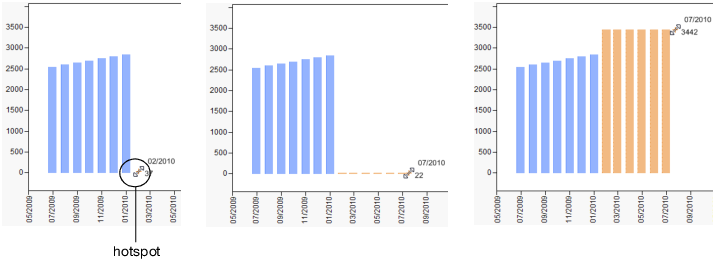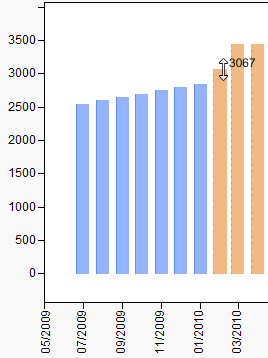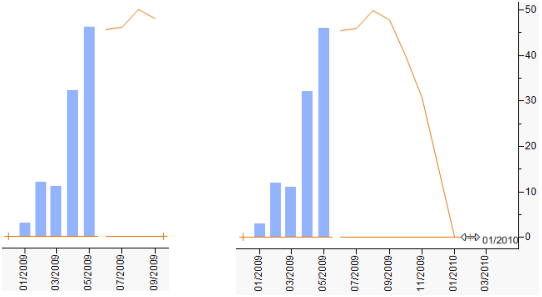Forecast Report
The Forecast report provides interactive graphs that help you forecast failures. By dragging hotspots, you can add anticipated production counts and see how they affect the forecast.
Adjusting Risk Sets
Future Production
In the left graph, the blue bars represent previous production counts. To add anticipated production, follow these steps:
1. Drag a hotspot to the right to add one or more production periods.
The orange bars represent future production.
Figure 9.11 Add Production Periods
2. Drag each bar upward or downward to change the production count for each period.
Figure 9.12 Adjust Production Counts
Tip: To adjust future production counts, click the Forecast red triangle and select Spreadsheet Configuration of Risk Sets. See Spreadsheet Configuration of Risk Sets.
Existing Production
To remove a risk set from the forecast results, right-click a blue bar and select Exclude. To return that data to the risk set, right-click and select Include.
Tip: To adjust existing production counts, click the Forecast red triangle and select Spreadsheet Configuration of Risk Sets. See Spreadsheet Configuration of Risk Sets.
Forecasting Failures
When you adjust production in the left graph, the right graph is updated to estimate future failures (Figure 9.13). Dragging a hotspot lets you change the forecast period. The orange line then shortens or lengthens to show the estimated failure counts.
Figure 9.13 Adjust the Forecast Period
Defining Risk Sets with Time to Event Data
You can obtain forecasts for arbitrary risk sets using the Time to Event Format tab. In the launch window’s Time to Event Format tab, you must select Numeric for the Life Time Unit and set the Forecast Start Time to zero. Enter appropriate columns for Time to Event, Censor, Freq, and Group ID.
The plot on the left provides locations for bars representing existing production. Drag the hotspot at 0 to the left to create existing risk sets. Drag the hotspot at 1 to the right to create future production risk sets.
You can specify existing and future risk sets using the Spreadsheet Configuration of Risk Sets option. For time-to-event data, you must enter negative time values for the existing risk set in the Future Risk area. See Spreadsheet Configuration of Risk Sets.
For an example that uses time-to-event data, see Additional Example Using the Reliability Forecast Platform.
Forecast Graph Options
To explore your data further, you can change the contract length, distribution type, and other options.
• To forecast failures for a different contract period, enter the number next to Use Contract Length. Change the time unit if necessary.
• To change the distribution fit, select a distribution from the Choose Distribution list. The distribution is then fit to the future graph of future risk. The distribution fit appears in the Life Distribution report plot, and a new profiler is added. Changing the distribution fit in the Life Distribution report does not change the fit in the Forecast graph.
• If you are more interested in the total number of failures over time, select Cumulative Counts. Otherwise, JMP shows failures incrementally, which can make trends easier to identify.
• To show 95% confidence limits for the anticipated number of failures, select Show Interval.
Forecast Report Options
The Forecast red triangle menu contains the following options:
Animation
Controls the flashing of the hotspots. You can also right-click a blue bar in the existing risk set and select or deselect Animation.
Interactive Configuration of Risk Sets
Determines whether you can drag hotspots in the graphs.
Spreadsheet Configuration of Risk Sets
Lets you specify production counts and periods (rather than adding them to the interactive graphs). You can also exclude production periods from the analysis.
– To remove an existing time period from analysis, highlight the period in the Existing Risk area, click, and then select Exclude. Or select Include to return the period to the forecast.
– To edit production, double-click in the appropriate Future Risk field and enter the new values.
– To add a production period to the forecast, right-click in the Future Risk area and select one of the Append options. (Append Rows adds one row; Append N Rows lets you specify the number of rows.)
As you change these values, the graphs update accordingly.
Note: If you launched the platform using the Time to Event Format tab, values for the existing risk set must be entered in the Future Risk area using negative time values.
Import Future Risk Set
Lets you import future production data from another open data table. The new predictions then appear in the future risk graph. The imported data must have a column for timestamps and for quantities.
Show Interval
Shows or hides 95% confidence limits in the graph. This option works the same as selecting Show Interval next to the graphs.
After you select Show Interval, the Forecast Interval Type option appears in the menu. Select one of the following interval types:
Plugin Interval
Considers only forecasting errors given a fixed distribution.
Prediction Interval
Considers forecasting errors when a distribution is estimated with estimation errors (for example, with a non-fixed distribution).
If you select Prediction Interval, the Prediction Interval Settings option appears in the menu. Approximate intervals are initially shown in the graph. Select Monte Carlo Sample Size or Random Seed to specify those values instead. To use the system clock, enter a missing number.
Use Contract Length
Determines whether the specified contract length is considered in the forecast. This option works the same as selecting Use Contract Length next to the graphs.
Use Failure Cost
Shows failure cost instead of the failure count in the future risk graph.
After you select Use Failure Cost, the Set Failure Cost option appears in the menu. This option enables you to set a cost for each failure. If you specified a Group variable in the launch window, the Set Failure Cost window enables you to specify separate costs for failures in each group.
Save Forecast Data Table
Saves the cumulative and incremental number of returns in a new data table, along with the variables that you selected in the launch window. For grouped analyses, table names include the group ID and the word “Aggregated”. Existing returns are also included in the aggregated data tables.


